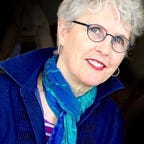The Whale Who Adopted a Village
When I recently read about a solitary beluga in Norway in the New York Times, it reminded me of my heart-opening encounter with another “lone, sociable” beluga in a Nova Scotian fishing village. Locals named this lost and friendly two-year-old beluga, “Wilma.” She would swim circles in the Guysborough Harbor using floating buoys as her toys. Soon, she was rubbing up against boats so often that her white flanks were sometimes gashed and scarred from propeller wounds.
Villagers invited the Canadian Whale Stewardship Project (WSP) to teach them how to protect and care for this seemingly orphaned beluga. Fishermen designed protective boxes for their boat engines. Researchers took DNA samples and discovered Wilma was from the highly endangered beluga population in the St. Lawrence River, near Saguenay, Quebec, 647 kilometers away. It is very uncommon for belugas to stray more than 100 miles from their native waters, even though those waters are now some of the most toxic in the world.
An international celebrity and tourist attraction, Wilma playfully approached boats to greet schoolchildren and tourists. Villagers set their clocks by her. One elder said, “In the evening, we like to hear Wilma snoring. It’s reassuring. We’re happy just knowing she’s out there.”
Belugas are among the most social and chatty of all whales, their musical range of whistles, shrieks, raspberries, moans, and ultrasonic shrills earn them the nickname “sea canaries.” Rarely is a beluga calf seen alone. Why was Wilma wandering so far away from her arctic waters? Loss of her mother and entire family pod must have left Wilma with an almost unendurable loneliness. Since touch and hearing are her primary senses, the soft bumping of a wooden fishing boat against Wilma’s back was like the nuzzling and rolling belugas do together in the wild; and the acoustic whine of an outboard engine might have mimicked beluga vocalizations.
“She’s a wild animal,” explained Cathy Kinsman co-founder of the WSP, which focuses on research and protection of belugas. “But Wilma is also part of everyday life in this village.”
When marine mammal biologist, Dr. Toni Frohoff of Terramar Research and my National Geographic co-author, Linda Hoga, and I ventured into the harbor to meet Wilma, our boatman, Lloyd spoke in almost a whisper. “Wilma trusts us, don’t you know? His grizzled, sun-darkened face was wide open and proud. “That’s why Wilma always comes back here . . . her home.”
I gasped when Wilma lifted up out of the waves to fix me with her bright, black eye. Her forehead smooth and silky, that permanent smile. Her regard was at once curious and intimate. How young she is, I thought. How much less aloof and even more playful than any wild or captive cetacean I’d ever encountered. Wilma had somehow learned about eye contact that made her seem more human, engaged. Her expression was childlike and subtly fixed, exactly like the long gaze a human infant will focus on a parent—as if imprinting everything about that person. Face, smell, texture of skin, and sound of a beloved voice.
In Wilma’s eye was all the homesickness and need, the dependence and pleasure of any human child. What I recognized most in Wilma’s expression was a searching and intense vulnerability. She was lost and she was found. She was alone of her kind yet surrounded by well-meaning people. Wilma had the plaintive and engaging look of a child awaiting adoption. And this village had the earnest and doting attitude of adoptive parents who must go through more scrutiny, more training, and more education than many birth parents.
As Wilma swam alongside our dinghy, letting us carefully rest our hands on her blazing forehead, careful to avoid her blowhole, she breathed out a cool, prismatic mist, what scientists call, “rainblows.”
“Yes, I see you,” I sang out to her. “Live long.”
Wilma let out a stream of high-pitched whistles, perfectly mimicking my notes. The same exact key.
For eight years, Wilma lived in Guysborough Harbor, coming and going as wild animals will. A local fisherman, Jim Johnson, formed an enduring bond with her. Then in the summer of 1999, she left the village perhaps to reunite with other belugas. Her last sighting was in 1999 by an airline pilot; another sighting was of a white whale, which many hoped was Wilma, swimming alongside a black pilot whale. Had Wilma, at sexual maturity, found a mate, even with another whale species?
“There is a world of whales just like Wilma,” Kinsman told me. “They are all worthy of our protection and respect. Wilma taught us so much about whales and also about ourselves.”
Some animals, like some people, find it is their fate to exist between the worlds and perhaps become bridges so that others may cross over. Wilma was a bridge to bring people to understand the perils and pleasures of beluga life in the wild. This was a another kind of family model—an interspecies kinship, new and fragile, awkward and inexperienced. But here was a glimpse of what the future might be, between species that must increasingly meet. We reach out past the bonds of one species and the boundaries that keep us lonely and limited. In an age of exploitation and extinction, we can choose to expand the way we love.~
This excerpt is from the author’s memoir, Build Me an Ark: A Life with Animals. For more on belugas read the author’s new book, Wild Chorus: Finding Harmony with Whales, Wolves, and Other Animals.
Video: “Where Whales and Humans Meet,” Wilma video from the Whale Stewardship Project.
Video: “Wilma, the Beluga Whale, Johnathan Bird’s Blue World,
For more on lone sociable belugas, “The Whale Who Went AWOL,” by Ferris Jabr, The New York Times magazine, January 14, 2024,
